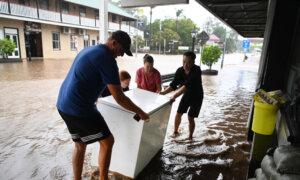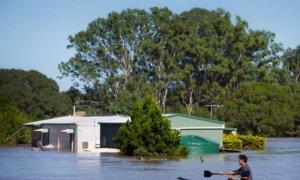Deadly Storm Approaching Australia’s Most Populous State, Prompts Travel Warning and Major Flooding Concerns
An inland low and coastal trough joining forces over New South Wales (NSW) is expected to bring heavy localized falls to much of the state on April 5.
Residents of Sydney and surrounding areas are advised to remain indoors as damaging winds and heavy rain move through, potentially causing life-threatening flash flooding.
Drivers are cautioned to avoid non-essential travel as the dangerous storm system impacts Australia’s eastern seaboard.
The forecast warns of 24-hour totals exceeding 200mm in Sydney and the south coast, with up to 300mm expected on the Illawarra Escarpment overlooking Wollongong.
The intense downpours could result in “dangerous and life-threatening flash flooding” starting in the evening of April 5, according to NSW’s State Emergency Service.
The SES is urging residents of Sydney, Gosford, Wollongong, Nowra, Batemans Bay, and Goulburn to stay indoors due to the hazardous weather conditions.
Significant flooding is likely along the Hawkesbury Nepean River bordering Sydney starting late on April 5, with Penrith expected to receive as much rain in a day as one-and-a-half Aprils.
Transport NSW has advised drivers statewide to avoid non-essential travel to ensure safety during the storm.
The storm has already resulted in a fatality in Queensland, with a man found near his ute in Logan, while heavy rain in northern NSW flooded enclosures at a wildlife sanctuary on April 4.
“Due to the significant influx of water into the park, we have relocated our animals and moved the hospital to a higher location,” Byron Bay Wildlife Sanctuary reported.
Despite memories of the catastrophic 2022 Northern Rivers floods, the SES highlighted that the current system is in motion.
“Unlike the previous floods in the Northern Rivers region, this system is moving as predicted,” said NSW SES Commissioner Carlene York.
“It stayed there, dumping rain continuously, which had a major impact.”
The SES volunteers have mobilized vehicles and vessels to respond proactively to potential danger zones.
Residents in vulnerable areas are urged to clear gutters and secure loose items in advance, stated Metro Zone Commander Allison Flaxman.
She recommended downloading the official Hazards Near Me app to stay updated on the latest alerts.
“The forecasts are quite severe,” she emphasized on Thursday afternoon, April 4.
The weather bureau noted that catchments in the north are fairly wet, while those around Sydney and the south coast are average to dry.
However, the possibility of water releases from the Hawkesbury Nepean River poses a threat, as Australia’s largest urban water supply dam, Warragamba Dam, on Sydney’s southwestern edge, is at 96% capacity as the storm approaches on Friday.





